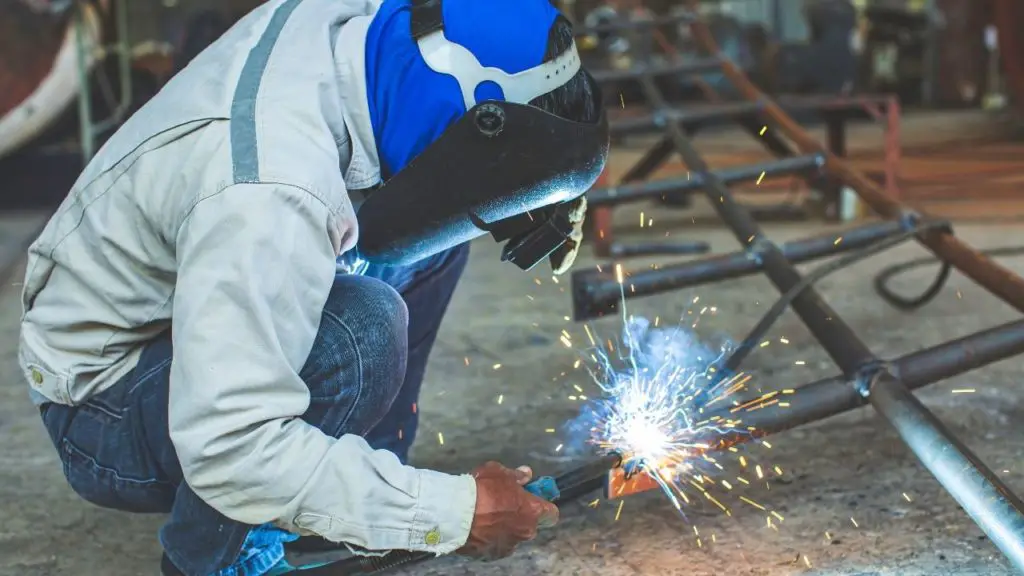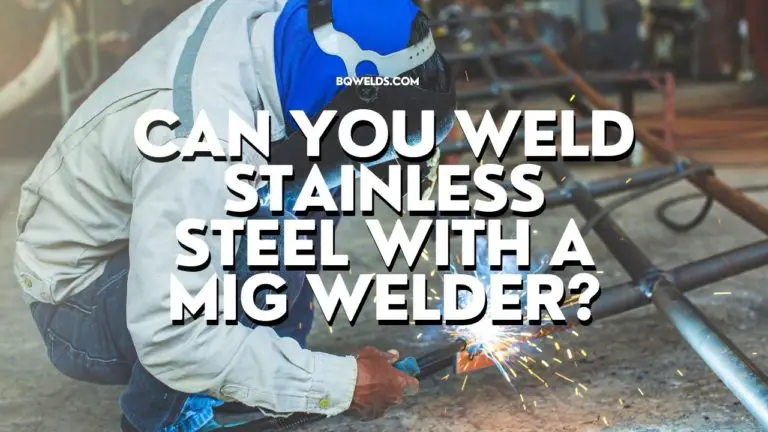Welding stainless steel can be intimidating for newcomers, but it doesn’t have to be. With the right technique and equipment, you can master this difficult material—and you don’t even need professional-grade gear.
In this blog post, we’ll discuss the basics of welding stainless steel with a MIG welder so that anyone from beginner welders to experienced professionals can confidently start their project.
Let’s arc it!
Welding Stainless Steel With A MIG Welder
It is possible to weld stainless steel with a Metal Inert Gas (MIG) welder.
The MIG welding process involves using a continuously fed electrode and protective gas to heat and join pieces of metal. Understanding the details and techniques of MIG welding stainless steel is critical for achieving optimal results, which we will delve into in this discussion.
Overview Of MIG Welding And Steel
MIG welding is a popular technique for combining metal pieces due to its simplicity and versatility. It is commonly used in the automotive, construction, manufacturing, and repair industries. MIG welding can be done using metals such as carbon steel, stainless steel, aluminum, etc.
However, welding stainless steel differs from other metals due to its unique properties.
Stainless steel is respected for its high strength, corrosion, and heat resistance. These properties make it popular for various applications, such as in the food and beverage industry, medical equipment, and architectural structures.
Choosing The Right MIG Welder For Stainless Steel
You should consider the following factors to choose the right MIG welder for your stainless steel welding needs.
- Power Output: The power output of the MIG welder should be sufficient enough to handle the thickness of the stainless steel you are working with. A higher amperage output is required for thicker stainless steel.
- Wire Diameter: The wire diameter used in MIG welding can range from 0.023 inches to 1/8 inch, and it’s crucial to select the right size for your project. Thicker stainless steel requires a thicker wire diameter.
- Gas Selection: Stainless steel welding typically requires a tri-mix gas blend, which consists of 90% helium, 7.5% argon, and 2.5% carbon dioxide. This mixture provides better penetration and produces a cleaner weld when compared to pure argon or other gas mixtures.
- Wire Tension: Proper wire tension is essential for MIG welding stainless steel, ensuring a constant and smooth electrode wire feed.

Benefits Of Using A MIG Welder On Stainless Steel
MIG welding stainless steel offers several distinct advantages:
- Efficiency: MIG welding is known for its high-speed performance. This efficiency makes it an attractive option for projects that involve welding large pieces of stainless steel.
- Versatility: MIG welding is versatile and capable of joining different types of stainless steel and other metals.
- Ease of Learning: The process of MIG welding is relatively easy to learn, making it a great starting point for beginners in the welding field.
- Clean Welds: When performed correctly, MIG welding can produce clean and aesthetically pleasing welds on stainless steel.
- Controlled Heat Input: MIG welding allows for more controlled heat input, reducing the risk of distortion or warping in the stainless steel.
- Strong Joint Formation: MIG welding can produce strong and durable joints, making it suitable for structural applications involving stainless steel.
Techniques For Welding Stainless Steel With A MIG Welder
Achieving a successful and strong weld on stainless steel requires proper technique. Here are some tips to help you get started:
- Cleanliness: Stainless steel is prone to contamination, so ensure your workpiece is clean and free of dirt or debris before welding. Ensure that the edges of the stainless steel pieces to be welded are clean and free of any gaps or misalignment.
- Use The Right Settings: Adjust the voltage and wire speed settings according to the thickness of the stainless steel and the wire diameter you are using. Refer to the welding machine’s manual for recommended settings.
- Angle Of The Gun: Hold the welding gun at a good angle for optimal results, and keep it steady while welding.
- Controlled Heat Input: Move the gun in a back-and-forth motion to distribute heat evenly
- Watch Your Travel Speed: Moving too slowly can cause excessive heat and burn-through, while moving too quickly may not create a strong enough weld. Experiment with different travel speeds to find the sweet spot.
- Tack Welding: Tack welding involves creating small, temporary welds along the seam of the stainless steel pieces. This technique helps to hold the pieces in place before making a full weld, reducing the risk of warping.
- Use Backing Gas: To prevent oxidation and improve weld quality, use backing gas on the backside of the welded area when possible.
- Practice, Practice, Practice: As with any welding process, practice makes perfect. Experiment and find what works best for your project.
Safety Precautions When Welding Stainless Steel With A MIG Welder
As with any welding process, safety should always be a top priority. Here are some precautions to consider when welding stainless steel with a MIG welder:
- Wear Protective Gear: This includes a welding helmet, gloves, and protective clothing to shield yourself from sparks and UV radiation.
- Ensure Proper Ventilation: Welding on stainless steel produces fumes that can be harmful if inhaled. Ensure you work in a well-ventilated area or use a fume extractor.
- Be Mindful Of The Heat: Stainless steel has a high thermal conductivity, which can quickly transfer heat to nearby objects. Keep flammable materials away from your work area.
- Use The Right Gas: Ensure you use the correct gas mixture for to ensure a safe and effective weld.
- Inspect Your Equipment: Regularly inspect your welding machine and equipment to ensure they are in good working condition. Faulty equipment can be dangerous.
Conclusion
In conclusion, MIG welding is an efficient and versatile method for welding stainless steel. Considering the abovementioned factors, proper techniques, and safety precautions, you can achieve strong and clean welds on your stainless steel projects with a MIG welder.


Add comment